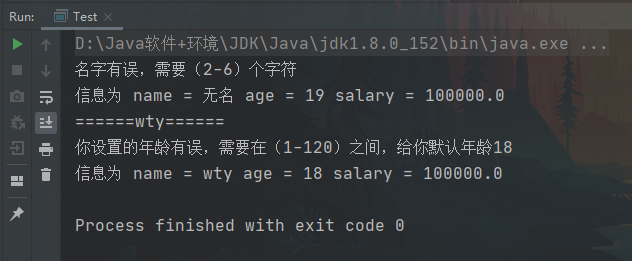第一步
第二步
提供公共的(public)方法(比如set方法,用于对属性判断并赋值)
public void setXxx(类型 参数名){ //加入数据验证的业务逻辑 属性 = 参数名; }
第三步
提供一个公共的get方法,用于获取属性值
public 数据类型 getXxx(){//权限判断 return XX; }
代码演示
public class Test {public static void main(String[] args) {Person person = new Person();person.name = "wty";//私有无权限//person.age = 19;//person.salary = 100000;person.setName("wtywtyw");person.setAge(19);person.setSalary(100000);System.out.println(person.info());System.out.println("======wty======");//如果我们使用构造器指定属性Person wty = new Person("wty", 2000, 100000);System.out.println(wty.info());}}class Person{public String name;//名字公开private int age;//年龄私有private double salary;//构造器public Person() {}//有三个属性的构造器public Person(String name, int age, double salary) {// this.name = name;// this.age = age;// this.salary = salary;//我们可以将set方法写在构造器中,任然可以验证setName(name);setAge(age);setSalary(salary);}//使用快捷键 Alt + Insert//可以根据需求进行具体的限制public String getName() {return name;}public void setName(String name) {//加入对属性的校验if(name.length() >= 2 && name.length() <= 6){this.name = name;}else{System.out.println("名字有误,需要(2-6)个字符");this.name = "无名";}}public int getAge() {return age;}public void setAge(int age) {//判断if(age >= 1 && age <= 120){//合理范围this.age = age;}else{System.out.println("你设置的年龄有误,需要在(1-120)之间,给你默认年龄18");this.age = 18;}}public double getSalary() {//可以增加对当前对象的权限判断return salary;}public void setSalary(double salary) {this.salary = salary;}//写一个方法,返回属性信息public String info(){return "信息为 name = " + name + " age = " + age + " salary = " + salary;}}


